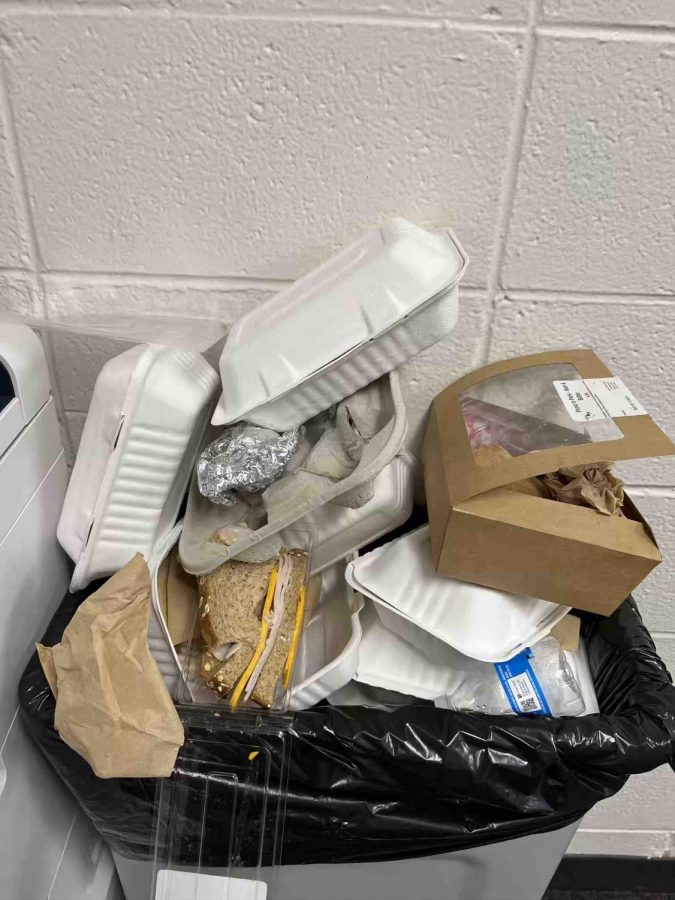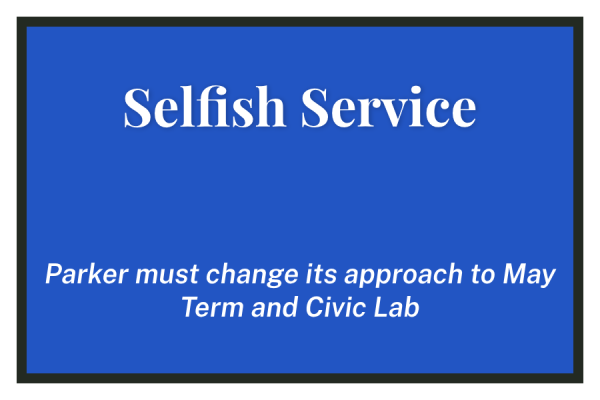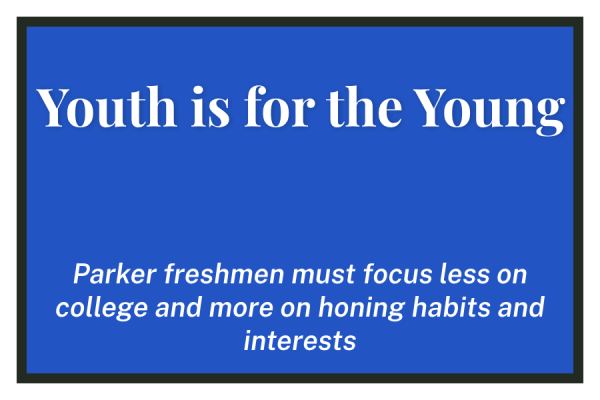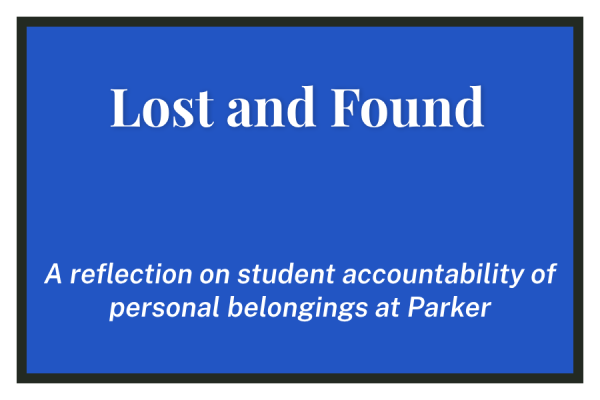Editorial, Issue 4 – Volume CXI –To-Go or Not To-Go
Help Stop Container Consumption Culture
Photo credit: Photo courtesy of Joe Bruno.
The third floor trashcan overflows with to-go containers and food waste. Photo courtesy of Joe Bruno.
Parker has had a culture of consumption for as long as time — a reflection of the culture in which we live. But COVID-19 has only exacerbated the problem, and it’s time we take a look at ourselves and our habits. Needless, barely touched plastic water bottles litter the hallways while water bottle filling stations sit dry and untouched. Cafeteria to-go containers build mountains in trash cans while reusable plates and silverware lie in the cafeteria unused.
Students offer many reasons for not using reusable foodware and water bottles. One is that old habits die hard. Students have been using to-go containers for what feels like a long time, and shifting to reusable foodware that can’t be thrown away is less convenient. This is true. But the minor inconvenience of bringing a plate down to the cafeteria — which might take anywhere from thirty seconds to two minutes — is a small price to pay for sustainability. There also seems to be a fear of dropping plates while making the trek from the cafeteria to an eating location, but risking the safe passage of mac and cheese or three slices of pepperoni pizza is a far less dire disaster than the culture of convenience, consumption, and waste at Parker.
It’s easy to start using a reusable plate. It is, at most, an extra two minutes out of a student’s day. You can even drop a dish off on the way to class if you’re headed to the Math or Science wing. It’s a simple fact that most students have the time to return reusable foodware to the cafeteria for cleaning — there are students who do it daily already.
Plastic water bottles, on the other hand, are in fact actually less convenient than using a reusable water bottle. There are easy-to-use water bottle filling stations within thirty seconds of nearly every classroom in the school, which is no doubt faster than a trip all the way down to the cafeteria. We’ve all had moments of laziness, but one extra item in your morning backpack can help you be lazier all day long.
Reusable water bottles are environmentally conscious as well as economically responsible. You can order a water bottle for as cheap as $8.99. A plastic bottle from the cafeteria is $1.75. Six days of buying plastic water and you’d be better off with a reusable one. In the month of October, the cafeteria sold a whopping 2274 bottles of water — about 113 bottles a day, and nearly $4,000. That’s a lot of money, and a lot of plastic waste. Buying a reusable bottle is a very small investment with a large return compared to buying a plastic water bottle every day.
If you know you’ll need to drink water each day (like we all do), and you see yourself spending money on a wasteful item — why not change it? You can be a part of transforming a destructive trend and culture in your community.
One piece of this culture is the atmosphere created by the students at Parker, one that often encourages fitting in from the brand of clothing you wear to the clubs you’re a part of. This social desire to fit in also translates to Parker’s reusable foodware dilemma.
There lies an unspoken stigma around reusable plates at Parker. It’s not “the norm.” A china plate is sure to stand out among tables littered with half-empty to-go containers. It begs the question: are students so hesitant about the plate transition because of how their friends will react? This insecurity is especially evident in situations where a student will walk the extra mile to make sure everyone knows their undying love for to-go containers, evident in the odes to the to-go container at Plenary.
To be clear, we’re not proposing that all to-go containers should be banned. We understand the need for disposable alternatives when back-to-back meetings and homework due next period are in the mix. Blaming your inability to ask for a plate on the flights of stairs or fear of spilling, however, doesn’t cut it. We need to make to-go containers the exception, not the rule.
Amending the Consumption Culture at Parker is a big task. But making small changes, like shifting to reusable foodware and water bottles, not only makes a small dent in our school’s waste but also a large shift in the mentality of students. While the direct waste footprint of each individual doesn’t amount to much in the grand scheme of our planet’s sustainability, the mentality shift it causes has the potential to do much more. By swapping out your container next lunch, you might develop a heightened sense of awareness of sustainability or pay closer attention to the impact of your own actions on the environment.
So after texting the Lunch Bot and running down to the cafeteria, make sure to ask the dedicated Quest staff to serve your meal on a plate. Put that Nalgene in your backpack before Clark 2 so you can refill it all day long. And on that extra walk back down to the cafeteria, take the time to feel good that you’re working to dismantle Parker’s culture.







